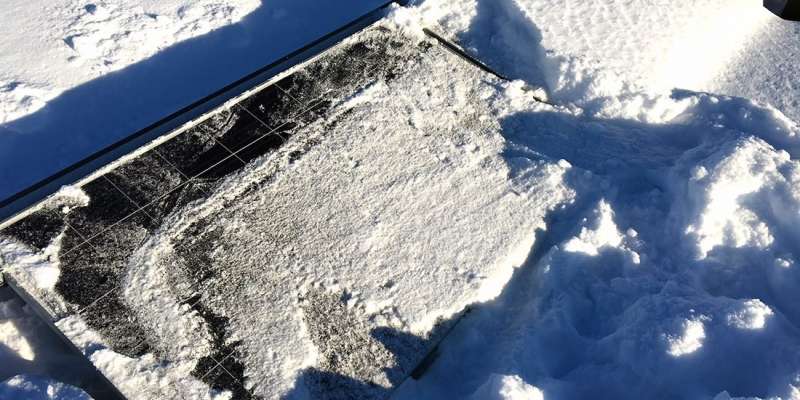How well do solar cells really work in the Nordic climate?

In recent years the price of solar cells has fallen so dramatically that more and more people are now looking to invest in solar panels. These can be installed either as free-standing structures on roofs, or as integrated components of construction modules such as roof slates or facade panels.
Traditionally, solar cells have been economically viable in countries with high electricity prices. Today, however, solar-generated electricity has become competitive even in Norway, despite the fact that we enjoy inexpensive hydroelectricity.
This has encouraged researchers to look into how effective solar cells really are under Norwegian climatic conditions. And so far the results are promising.
"Our experiments show that solar cells function very well under Nordic climate and weather conditions," says Research Manager Eivind Øvrelid at SINTEF. "Moreover, computations made by the European Technology and Innovation Platform PV (ETIP-PV/etip-pv.org) show that it is economically viable to invest in solar-generated electricity from day one, provided you consume the electricity yourself," he says.
"This assumes that we're talking about a plant of about 1 MWp, and that interest rates hold their current levels," says Øvrelid.
The costs of investing in solar electricity: Capital costs are key to the price of solar electricity. Our comparison is with costs taken from the distribution grid, which in Norway applies to electricity generated by hydropower.
A self-evident solution?
In order to find out how non-reliant solar cells are on clear weather and sunshine in order to generate electricity, researchers at SINTEF have installed the technology in a climate chamber. Normally, such chambers are used to test the robustness of materials such as window claddings and other construction materials in harsh weather conditions.
Output from the solar cell panels is tested under different temperatures, light rain, heavy rain, snow, and situations in which ice forms on the panels.
The climate chamber is installed with ceiling lamps that simulate solar radiation, making it possible to conduct experiments using entirely constant levels of illumination, while varying the weather conditions.
"Moreover, it was important to us to establish a reference value for solar radiation in order to ensure that conditions were identical during all our experiments," explains NTNU student Gina Opstad Andersen. "For this reason, we connected up a solar cell fitted with a sensor that made it possible to calculate the level of radiation that the cells were exposed to in the chamber," she says. Opstad Andersen took part in the experiments as part of her Master's studies at NTNU, and was responsible for constructing the test apparatus.
Cold increases output and rain is no problem
Using a potentiostat, researchers were able to measure the electrical output generated by solar cells under different experimental conditions.
"The results confirmed observations we had made before showing that the panels work very well in cold weather," says Øvrelid.
A cold environment may be an asset to a solar cell panel used to generate electrical energy because it keeps the cells' operational temperature at low levels. High temperatures increase the cells' "internal energy leakage" because electrons are more active in warm conditions. In the case of the silicon-based solar cell used in our experiment, output was reduced by about 0.3% for each degree of temperature increase.
Temperature exerts its greatest influence on voltage or, put simply, the force that mobilises the electrons. Voltage increases when the weather is cold, and this makes the cells generate more output.
Solar radiation (a measure of solar energy) controls the amount of electricity that the cells generate. It can be very intense in winter, especially if sunlight is reflected by fresh snow. These two factors combine to produce the electrical output we obtain flowing from the plug in the wall. In other words, sunshine and cold weather are ideal conditions for solar cells.
What has surprised the researchers is that the cells withstood rainy conditions very well. Experiments involving light rain gave positive results.
"The solar rays simply pass straight through the rain," says Øvrelid. "The rain had no effect on the amount of incoming radiation. The same happened when the cells were covered by a layer of ice," he says.
A solar power station in Svalbard?
When either snow or opaque ice cover solar panels, this results in a distinct shadow effect. So, the advice to owners is to keep your panels clear of snow. If opaque ice forms on a panel it may be a good idea to melt it using lukewarm water.
"But whatever you do, don't try to scrape it off," says Øvrelid. "This could damage the solar cell," he says. He also recommends that the cells are given a thorough cleaning twice a year. Both chimney soot and air-borne dust from roads have been shown to reduce the panels' efficiency.
Solar cell researchers at SINTEF now want to launch a new project to look into solar cells as possible sources of electricity in Svalbard. The challenge here is to find an effective way of storing the surplus energy.
Provided by SINTEF





















